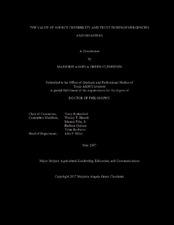| dc.description.abstract | Individuals today face many threats and rely on appropriate guidance to protect their person, property, and pets. Response to hazardous events such as natural disasters, disease outbreaks, food safety concerns, terrorism, chemical plant explosions, petroleum spills, and radiological releases requires individuals to quickly seek and process highly scientific information, often with conflicting opinions prior to deciding to act. This chaotic environment makes decision-making a very complex task.
Risk communication represents a subset of communication practice designed to influence individual perception of risk and to inform audiences of potential risks, thereby empowering individuals to make protective action decisions resulting in the mitigation of or minimizing the impact of the risk. To accomplish these feats, those charged with disseminating public information must be part journalist, part anthropologist, part psychologist, part public relations practitioner, part scientist, and part organizational strategist. Early research in the risk disciplines focused on the information itself. Over time, this focus changed to include the channels through which risk messages are delivered and how information is sought and processed. Improving risk communication efforts requires a cross-disciplinary approach integrating research and theory from a psychological paradigm, an emergency and risk management paradigm, a communications paradigm, and a diffusion of innovation paradigm, which provides a conceptual framework to investigate the dimensions of source credibility and trust and how individuals assign these values to the information sources available during a time of crisis. Using a Q method approach integrating the thick, rich descriptions of qualitative research for context with quantitative factor analysis of the data, each individual participant is recognized as a holistic unique variable. This approach also allows for the discovery of common themes within groups of individuals and how these individuals determine source credibility and trust. Findings from this study lead to the ability to examine trust and the projection of trust by characterizing distinct points of view. Each distinct point of view then realizes important implications for the future of risk communication practice in regards to messages and messengers.
Conclusions from the study demonstrate the importance of honesty/integrity, altruism/benevolence, and salient values to the individual characterization of trust through the emergence of three distinct points of view reflecting each of these characteristics or a combination of the three. Also discovered were four different points of view regarding how trust is projected onto sources of information. These were defined primarily by proximity to the individual (federal/state-level, county-level, community-level) and by perception of self-sacrifice and servanthood. Including context from the exit interview, this study ultimately supports the idea of empathy and expertise as leading components of trust. However, it presents these concepts as much more complex than indicated in previous research. In addition, this study demonstrates the differences in how expertise and empathy, defined individually, are projected onto potential sources of information. The results of this study also contributes to further discussion regarding Q method as a viable technique for investigating and exploring subjective concepts such as trust and trustworthiness and how these are projected on to individuals. | en |


